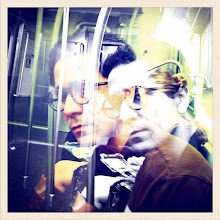
'Ambassadors' by Hans Holbein the Younger, son of Holbein the Elder. The distorted object center is a skull that comes into perspective when the viewer looks up from the bottom left corner
Poetry of the subject within the true subject, or vice versa
Skull pushes outward as 'world' shoots up through the material 'earth' of the painting; in human terms: The canvas, oils, strokes are the material BUT when we look at the skull from the corner, seeing it jut out in perspective, while maintaining that we are still looking at a painting, the idea of the painting (skull) is projected forward and free from it.
Skull is held by materials -- essentially defined by 'em but additionally outside their boundary. Like watching mist above the ocean. It is still essentially water but already something else
Between the two positions, the spectator is free: Unrestricted to the material of the painting and able to spread from it in rhetorical expansion
This is the nature of Jonathan Edwards' 'active ideas,' ideas felt, living organisms of thought
APOSTROPHE TO SARAH PIERPONT (c. 1723)
They say there is a young lady in [New Haven] who is beloved of that almighty Being, who made and rules the world, and that there are certain seasons in which this great Being, in some way or other invisible, comes to her and fills her mind with exceeding sweet delight, and that she hardly cares for anything, except to meditate on him-- that she expects after a while to be received up where he is, to be raised up out of the world and caught up into heaven; being assured that he loves her too well to let her remain at a distance from him always. There she is to dwell with him, and to be ravished with his love and delight forever. Therefore, if you present all the world before her, with the richest of its treasures, she disregards it and cares not for it, and is unmindful of any pain or affliction. She has a strange sweetness in her mind, and singular purity in her affections; is most just and conscientious in all her actions; and you could not persuade her to do anything wrong or sinful, if you would give her all the world, lest she should offend this great Being. She is of a wonderful sweetness, calmness and universal benevolence of mind; especially after those seasons in which this great God has manifested himself to her mind. She will sometimes go about from place to place, singing sweetly; and seems to be always full of joy and pleasure; and no one knows for what. She loves to be alone, and to wander in the fields and on the mountains, and seems to have someone invisible always conversing with her.
Intent is to fuse (by syntax, grammar, and style) Sarah Pierpont with the Being so that it surfaces clear when we read, 'seems to have someone invisible'
I will be brief: First half of first sentence, the phrase ending with the dash, creates a structure of Being/Quality of the Being, Being/Quality of the Being, Being's action/Sarah's Quality/Being acting through Sarah;
Next phrase we see them raised up out of the world to heaven
Then, stressed, 'BEING assured...' the phrase is in passive construction; The BEING working through Sarah. They are syntactically fused.
'There she is to dwell with him and to be ravished with his love and delight forever,' Sarah locally fused with being (domestic images) and somewhat sexual too
NEXT FOLLOW QUALITIES OF SARAH PIERPONT AS EXHIBITED BY THE BEING WORKING THROUGH HER
Complete concatenation of Sarah's qualities with the GREAT BEING'S in A/B/A/B structure. We've received it enough to feel it even if we don't think about it
The last two lines have been arranged so that the two phrases, 'and no one knows for what' and 'someone invisible' are READ as the GREAT BEING. In the last two lines the Being is there and not there; we sense him with a different apparatus than that which the rest of the apostrophe functions by
We stand in the lower-left corner; idea surfaces from the material
.jpg)




No comments:
Post a Comment